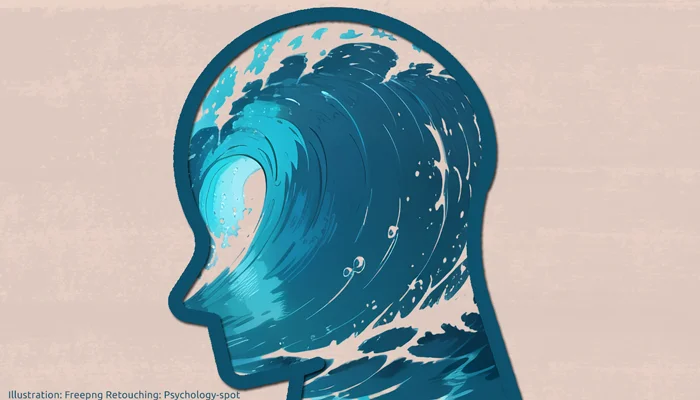
While we go jogging or on our way to work, a meteorite can hit us. It’s a possibility, but so remote that we don’t normally think about it. Catastrophic people, on the other hand, do it. They spend much of their day imagining the worst calamities by drawing a post-apocalyptic scenario.
The truth is that all of us, from time to time, put into practice a catastrophic thinking that plunges us into an ocean of terrifying and unlikely possibilities. This is what we do when we start the day with a bad footing and automatically think that our day has been ruined. However, when that way of thinking becomes the norm we will have a problem and we are likely to end up suffering from anxiety or depression.
What is catastrophic thinking?
Catastrophic thinking, or catastrophism, is a cognitive bias that leads us to imagine the worst possible scenarios, leading us to feed a series of irrational beliefs that end up affecting our attitudes, behaviors and decisions.
It is an irrational belief because we assume that a disaster will occur, even if we do not have reasonable grounds or reliable clues that confirm that. It is like when a hypochondriacal person self-diagnoses a serious illness from a small pain.
Catastrophism, in Psychology, implies assuming that negative events will occur that eventually fail to materialize, but despite the fact that we are systematically wrong in our assumptions, we fail to incorporate the evidence and continue to feed that catastrophic thinking.
What is the origin of catastrophic thinking?
Catastrophic thinking has its roots in evolution. Our brain reacts automatically to the smallest warning signs because it could save our lives. We also have an extraordinary facility to react with fear to ambiguous and uncertain scenarios. In practice, our brain prepares for the worst to protect and defend us.
That means that catastrophism is a normal response, the problem begins when that reaction remains permanently activated and affects all areas of our lives. At that time, catastrophism becomes a maladaptive coping style that causes us more harm than good, since it keeps us in a constant state of alertness, as if turning every corner is awaiting us an imminent danger.
Why do some people get caught in a loop of catastrophic thoughts?
Beyond our evolutionary conditioning, catastrophism is also something that is learned. The experiences of our childhood can leave a deep mark, especially if we have been transmitted the message that the world is a dangerous and hostile place, so that we must be prepared to defend ourselves at any moment.
Subsequent and negative life experiences can also leave their mark, so that fear becomes widespread until it becomes a pattern of automatic response. Once that pattern is established, catastrophic thinking will be increasingly common and will trigger an intense emotional response that will make us feel bad.
Forming a storm in a teacup – and drowning in it
Catastrophic people tend to turn a small setback into a dantesque scenario, end up making a storm in a teacup and are even likely to end up drowning in it.
Their irrational beliefs generate worry, anxiety and fear of living. In fact, catastrophic thinking by anxiety have been linked to a greater tendency to get angry and express anger in a maladaptive way. It has also been linked to more ideas about revenge and resentment, as well as less tolerance for pain.
It is obvious that if we exaggerate the consequences of the negative things that happen to us, we will feel sad and angry. It is also obvious that imagining everything bad that can happen generates a state of permanent anxiety and stress that will end up taking its toll.
In fact, the worst of all is that catastrophic predictions end up being prophetic because we ourselves – unconsciously – take care that these fears are fulfilled. A hypochondriacal person, for example, may end up developing more serious diseases precisely because of the state of constant stress in which he lives because of his catastrophic thinking.
Techniques to eliminate catastrophic thinking
1. Activate the rational mind. Resort to statistics.
The first step is to detect catastrophic thinking. It may seem banal, but the truth is that most of the people who activate these beliefs are convinced that their fears are completely founded.
We need to understand that our brain constantly estimates the probabilities that exist for a particular event to occur. To do this, it follows two analysis guidelines: one logical and rational and one based on your experiences.
According to logic, airplanes are the safest means of transport, but a person who is afraid of flying will not rely on these statistics, but on his own fears or experiences. As a result, he will not distinguish between reality and his fears, between what is objectively true and how much it has been added by his imagination.
Therefore, it is convenient to ask ourselves: What evidence do I have in favor of my thoughts? What evidence do I have against? Do I make these kinds of judgments when I feel good or only when I am anxious, sad or frustrated?
2. Think about the consequences of the event. Use the right words.
Once we activate the rational mind, we must try to think about the consequences of that event objectively. If the train is delayed 10 minutes, will it be a nuisance or a catastrophe? What is the worst that can happen with that delay?
In some cases, it could cause serious problems, but in most cases it will be nothing more than a simple setback. Catastrophist people need to pay more attention to the words they use because they will end up influencing their worldview.
Therefore, it is important to put things in perspective and use the right words to rate situations and their consequences, escaping the tendency to use typical catastrophic qualifications. One technique to eliminate the catastrophic thinking is to think what we would say to a person who is going through something similar, it is likely that our words are more conciliatory and reassuring than those that we address ourselves.
3. Change the catastrophic idea. Without falling into naive optimism.
Once we have identified the catastrophic thinking, it is convenient to replace it with more realistic thinking. However, it is important not to minimize its consequences and avoid excessive optimism since our brain will not be easily deceived.
If something very disappointing has happened to us, we cannot solve it either by telling ourselves that everything is fine and pretending that nothing has happened. That attitude is not healthy. We need to understand that things can be moderately bad, but they can also become very bad, and when they do it, we need to recognize it to find solutions.
However, when things are not so bad, we should restructure our thinking in order to analyze what happens from a more objective position. For example, instead of thinking that “the rain has completely ruined my day”, we may think that “I feel disappointed because I have not been able to do what I wanted” and so find an alternative that suits us.
Sources:
Okifuji, A. & Turk, D. C. (2016) Chronic Pain and Depression: Vulnerability and Resilience. Neuroscience of Pain, Stress, and Emotion; 181-201.
Martin, R. C., Vieaux, L. E. (2013) Angry thoughts and daily emotion logs: Validity of the Angry Cognitions Scale. Journal of Rational-Emotive and Cognitive Behavior Therapy; 29: 65-76.
Frey, L. et. Al. (2013) Pain intensity mediates the state-trait catastrophizing relationship: a path analysis study. The Journal of Pain; 14(4): S21.



